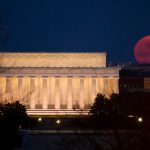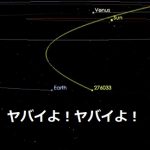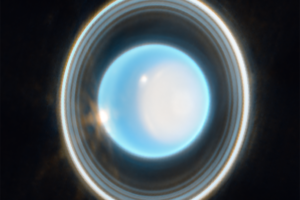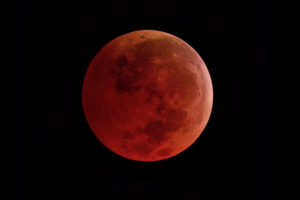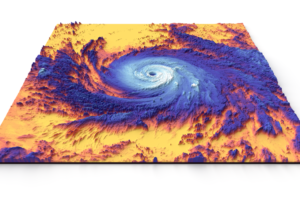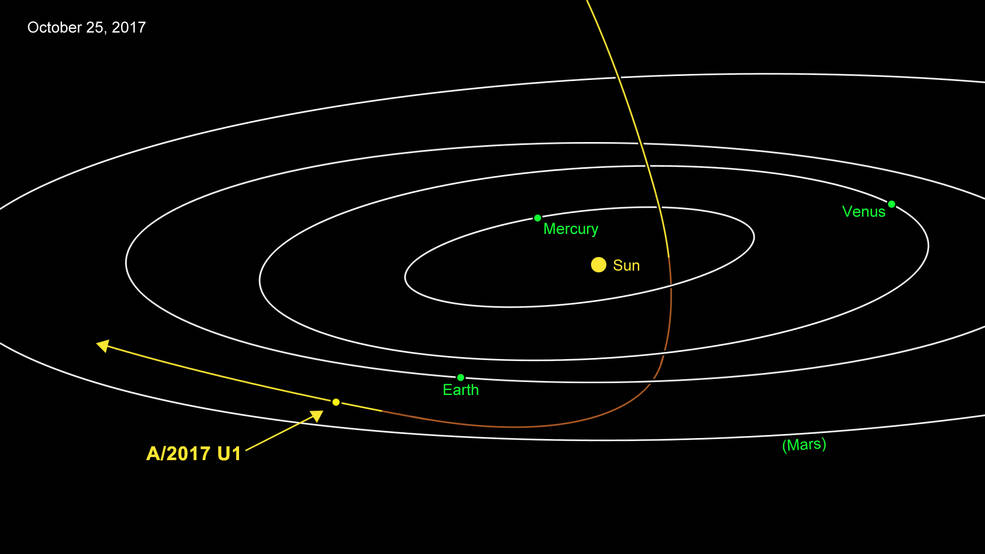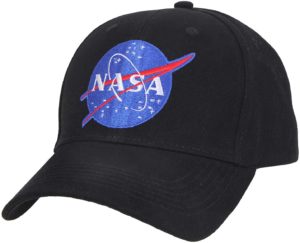2018年1月31日のスーパームーンはブルームーンでありブラッドムーンでもあります。
つまり「青い月」であり「血に染まったような色の月」ということです。
えっ?青と赤ってどういうこと?
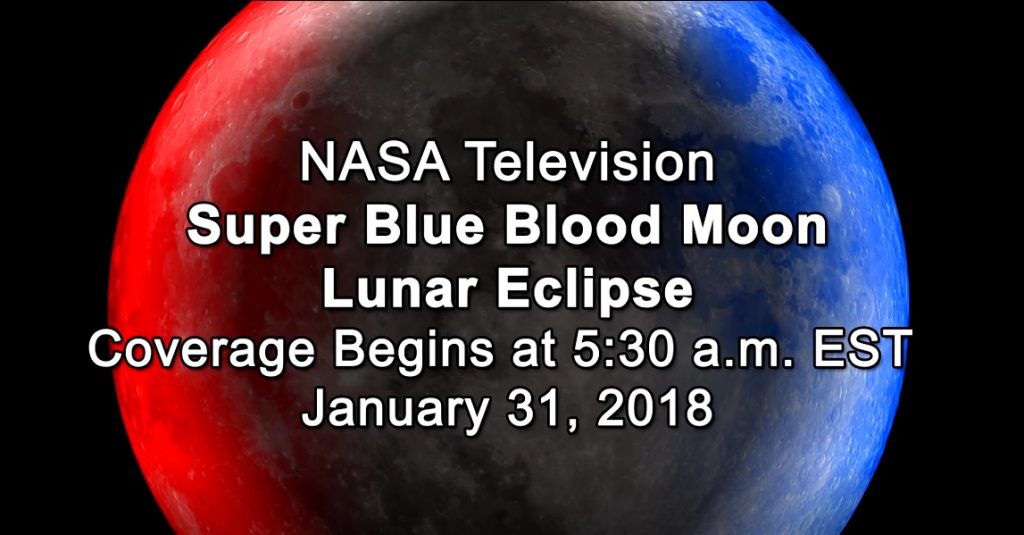
まさか、こんなことにはなりません。
その答えはNASAの動画と記事本文をご覧ください。
なぜスーパーブルームーンが血の色に染まるのか!
‘Super Blue Blood Moon’ Coming Jan. 31
If you live in the western part of North America, Alaska, and the Hawaiian islands, you might set your alarm early the morning of Wednesday, Jan. 31 for a lunar trifecta: a pre-dawn “super blue blood moon.”
北米、アラスカ、ハワイ諸島の西部に住んでいる人は、1月31日水曜日の朝早くにアラームをセットするでしょう。何故なら「スーパーブルーブラッドムーン」が観られるからです。
Beginning at 5:30 a.m. EST on Jan. 31, a live feed of the Moon will be offered on NASA TV and NASA.gov/live. You can also follow at @NASAMoon.
1月31日午前5時30分からNASAテレビとNASA.gov/liveで実況中継が配信されます。@ NASAMoonでフォローできます。
“For the (continental) U.S., the viewing will be best in the West,” said Gordon Johnston, program executive and lunar blogger at NASA Headquarters in Washington. “Set your alarm early and go out and take a look.”
「米国(大陸)では、西側が一番よく観えるでしょう。」と、ワシントンのNASA本部の執行幹部であり、月刊ブロガーのゴードン・ジョンストン(Gordon Johnston)は言いました。「あなたの目覚まし時計を早めに設定しておき、外に出て自分の目で観てみましょう。」
The Jan. 31 full moon is special for three reasons: it’s the third in a series of “supermoons,” when the Moon is closer to Earth in its orbit — known as perigee — and about 14 percent brighter than usual. It’s also the second full moon of the month, commonly known as a “blue moon.” The super blue moon will pass through Earth’s shadow to give viewers in the right location a total lunar eclipse. While the Moon is in the Earth’s shadow it will take on a reddish tint, known as a “blood moon.”
1月31日の満月は、3つの理由から特別な満月です。月の軌道が地球に近づく3番目の「スーパームーン」で、通常よりも約14%月が明るく観えます。また1か月間で2回目の満月であり一般に「ブルームーン」と呼ばれています。スーパーブルームーンはその軌道から地球の影を通過するので、地球から観る人には良い場所にいると完全な月蝕になります。月が地球の影にある間、「ブラッドムーン」として知られる赤みを帯びた色合いになるでしょう。
If you live in North America, Alaska, or Hawaii, the eclipse will be visible before sunrise on Jan. 31. For those in the Middle East, Asia, eastern Russia, Australia and New Zealand, the “super blue blood moon” can be seen during moonrise in the evening of the 31st.
北米、アラスカ、ハワイに住む人には、1月31日の日の出前に日蝕が観えるでしょう。中東、アジア、ロシア東部、オーストラリア、ニュージーランドの人々には、「スーパーブルー・ムーン・ムーン」は31日の夕方の月の出から観ることができるでしょう。
“Weather permitting, the West Coast, Alaska and Hawaii will have a spectacular view of totality from start to finish,” said Johnston. “Unfortunately, eclipse viewing will be more challenging in the Eastern time zone. The eclipse begins at 5:51 AM ET, as the Moon is about to set in the western sky, and the sky is getting lighter in the east.”
「天気が良ければ、西海岸、アラスカ、ハワイでは、最初から最後まで全部の素晴らしい天体ショーを堪能することができます。」とジョンストンは言いました。「残念なことに、東部時間帯の人は月蝕を観ることが困難になります。月蝕は東部時間で午前5時51分に始まりますので、西側の空での月蝕が東側の空が明るくなり見え難くなるからです。」
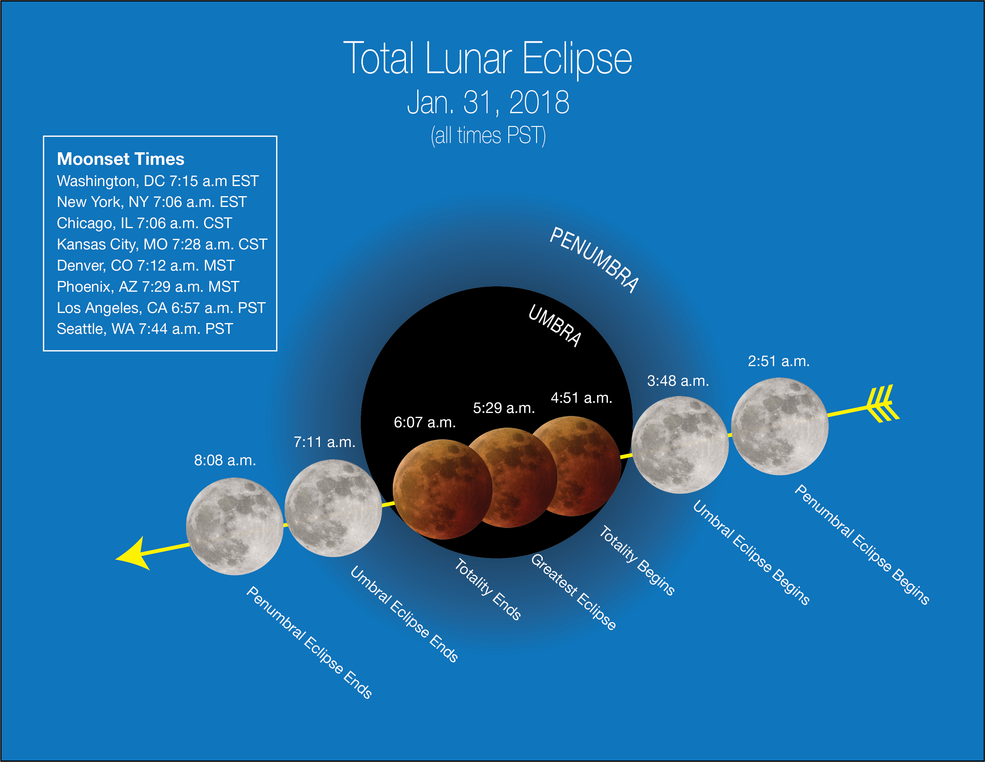
Stages of the Jan. 31, 2018 “super blue blood moon” (weather permitting) are depicted in Pacific Time with “moonset” times for major cities across the U.S., which affect how much of the event viewers will see. While viewers along the East Coast will see only the initial stages of the eclipse before moonset, those in the West and Hawaii will see most or all of the lunar eclipse phases before dawn. Credits: NASA
So for viewers in New York or Washington, D.C., the Moon will enter the outer part of Earth’s shadow at 5:51 a.m., but Johnston says it won’t be all that noticeable. The darker part of Earth’s shadow will begin to blanket part of the Moon with a reddish tint at 6:48 a.m. EST, but the Moon will set less than a half-hour later. “So your best opportunity if you live in the East is to head outside about 6:45 a.m. and get to a high place to watch the start of the eclipse—make sure you have a clear line of sight to the horizon in the west-northwest, opposite from where the Sun will rise,” said Johnston.
ニューヨークやワシントンで観測するには、月は午前5時51分に地球の影の外側に入りますが、ジョンストンはそれほどハッキリとはしないと言っています。地球の影の暗い部分は、東部時間午前6時48分に赤い色で月の一部を覆い始めて30分以内に赤くなります。「あなたが東部に住んでいるなら、あなたにとって最高の観測タイミングは午前6時45分頃に外に出て、月蝕の始まりを見るために高い場所に行くことです。日の出の反対側となる北西の地平線がハッキリとわかるところです。」と、ジョンストンは言いました。
If you live in the Central time zone, viewing will be better, since the action begins when the Moon is higher in the western sky. At 4:51 a.m. CST the penumbra — or lighter part of Earth’s shadow – will touch the Moon. By about 6:15 a.m. CST the Earth’s reddish shadow will be clearly noticeable on the Moon. The eclipse will be harder to see in the lightening pre-dawn sky, and the Moon will set after 7:00 a.m. as the Sun rises. “So if you live in Kansas City or Chicago, your best viewing will be from about 6:15-6:30 a.m,” said Johnston. “Again, you’ll have more success if you can go to a high place with a clear view to the West.”
あなたが中部のタイムゾーンに住んでいるなら、西の空高くに月が上がったときに観測を始めれば良いでしょう。中部時間午前4時51分に、地球の影の半分が月にかかってくるでしょう。中部時間午前6時15分までには、地球の赤い影が月にはっきりと観えるようになるでしょう。夜明け前の明るい空では月蝕が見づらくなり、太陽が上がる午前7時以降には月は元に戻ります。 「もしあなたがカンザスシティやシカゴに住んでいれば、最高の時間帯はだいたい6時15分から6時30分になります。」とジョンストンは語りました。「あなたが西の方角で標高の高いところに行くことができれば、再び観ることができるでしょう。」
In the Rocky Mountain region, the show begins as the umbra touches the edge of the Moon at 4:48 a.m. MST. The peak of the blood moon eclipse is at about 6:30 a.m. local time, and the Moon will set shortly after 7 a.m.
ロッキー山脈地域では、午後4時48分に月の縁に地球の影がかかるとショーが始まります。血の色の月蝕のピークは、現地時間午前6時半頃で、午前7時を過ぎると元に戻ります。
Californians and viewers in western Canada will be treated to the total eclipse phase from start to finish, though the penumbral shadow will pass after the Moon has set. The umbral eclipse begins at 3:48 a.m. Pacific Time. At 4:51 a.m., totality will begin, with best viewing between about 5:00 and 6:00 a.m. local time. The totality phase ends about 6:05 a.m.
カナダ西部とカリフォルニアの人は、地球の陰が通過する最初の段階から終わりまでの全体的な月蝕を観ることができそうです。月蝕は太平洋時間3時48分に始まります。現地時間午前4時51分には全体的に及んでいて、午前5時から午前6時までの間は最高の状態で観ることができます。全てが終了するのは午前6時5分頃になります。
Weather permitting, eclipse fans in Hawaii will experience the lunar eclipse from start to finish, as will skywatchers in Alaska, Australia and eastern Asia.
天気が良ければ、アラスカ、オーストラリア、東アジアの観測者たちと同様に、ハワイの月蝕ファンも最初から最後まで観測することができます。
If you miss the Jan. 31 lunar eclipse, you’ll have to wait almost another year for the next opportunity in North America. Johnston said the Jan. 21, 2019 lunar eclipse will be visible throughout all of the U.S. and will be a supermoon, though it won’t be a blue moon.
1月31日の月蝕を見逃した場合は、北米では次の機会まで一年待たなければなりません。ジョンストンは2019年1月21日に月蝕が米国全土に見られ、スーパームーンになるとしましたがブルームーンではありません。
Johnston has been following and writing about the Moon since 2004, when he and about 20 colleagues at NASA Headquarters would get together after work during the full moon in “celebratory attire”—which for Johnston meant his signature bow tie. Long after the socializing fell by the wayside, Johnston’s monthly blog lives on, with a dedicated following on NASA’s lunar website, moon.nasa.gov.
ジョンストンは、2004年以来月に関する執筆活動に従事しており、NASA本部の約20人の同僚が満月の仕事の後に集まり、ジョンストンのサイン入りの蝶ネクタイをした礼装で集まります。長期にわたる民間への周知広報活動はジョンソンの月刊ブログで継続されており、詳細にはNASAの月関係のウェブサイトmoon.nasa.govに掲載されています。
Said Johnston, “I have always been fascinated by the night sky. Most of what we can see without a telescope are points of light, but the Moon is close enough that we can see it and the features on it, and notice what changes and what stays the same each night.”
ジョンストンは、「私はいつも夜空に魅了されてきました。私たちが望遠鏡なしで見ることのできるものの大部分は光の点ですが、月は近くにあり、月面までも良く観ることができます。毎晩何が変化し、何が変化していないのかを知ることができます。」
To watch a NASA ScienceCast video, A Supermoon Trilogy about the Dec. 3, 2017, Jan. 1, 2018, and Jan. 31, 2018 supermoons, click here.
NASAのScienceCastビデオで、2017年12月3日、2018年1月1日、2018年1月31日のスーパームーンについての三部作を観るにはこちらをクリックしてください。
Love to observe the Moon? It’s easy to make a Moon Phases Calendar and Calculator that will keep all of the dates and times for the year’s phases of the Moon at your fingertips.
月を観察するのが大好きですか?あなたの指先で月の年の相の全日時を盛り込んだ月位相カレンダーと計算機を作るのは簡単です。
Take notes and record your own illustrations of the Moon with a Moon observation journal, ready to download and print at moon.nasa.gov.
月観測誌でノートをとりイラストを記録するだけで、Moon.nasa.govではダウンロードして印刷することができます。
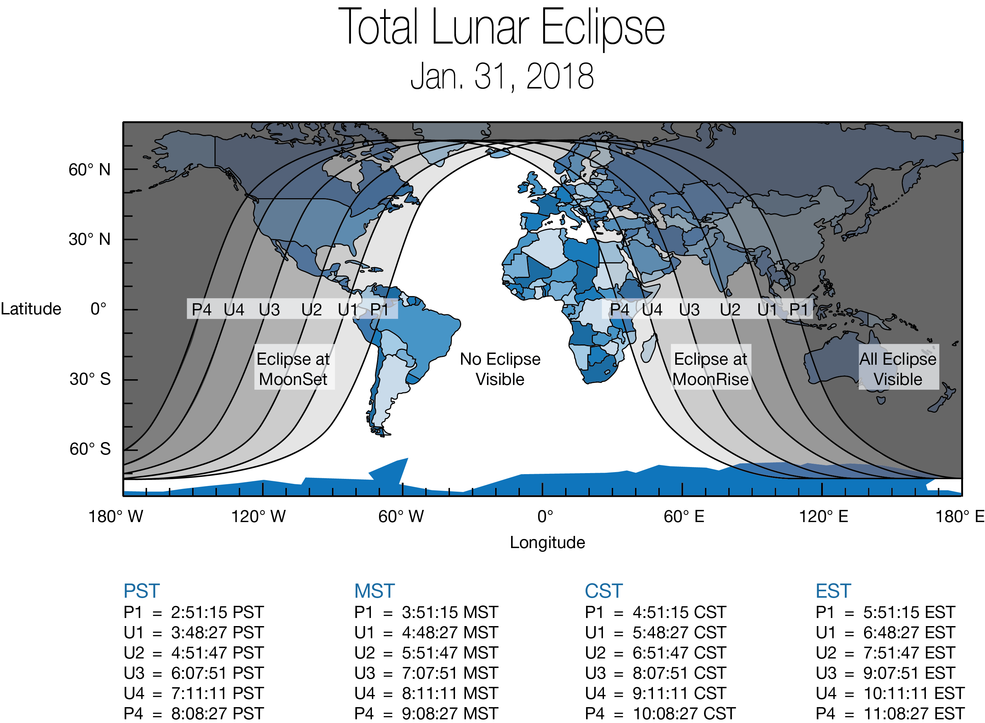
Global map showing areas of the world that will experience (weather permitting) the Jan. 31, 2018 “super blue blood moon.” The eclipse will be visible before sunrise on Jan. 31 for those in North America, Alaska and Hawaii. For those in the Middle East, Asia, eastern Russia, Australia and New Zealand, the “super blue blood moon” can be seen during moonrise the evening of the 31st. Credits: NASA

